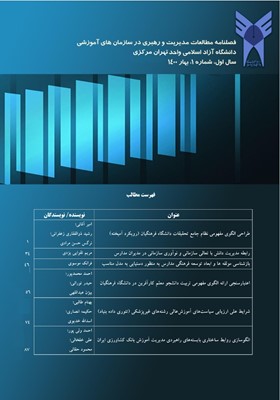بازشناسی مولفه ها و ابعاد توسعه فرهنگی مدارس به منظور دستیابی به مدل مناسب
محورهای موضوعی : مدیریت آموزشی
1 - دانشیار گروه مدیریت آموزشی ، دانشکده ادبیات و علوم انسانی ، واحد کرمانشاه ، دانشگاه آزاد اسلامی ، کرمانشاه ، ایران
کلید واژه: نظریه داده بنیاد, توسعه فرهنگی مدرسه, ابعاد توسعه فرهنگی,
چکیده مقاله :
هدف از انجام این پژوهش کنکاش مؤلفهها و ابعاد توسعه فرهنگی مدارس بهمنظور ارائۀ مدل توسعه فرهنگی مدارس بوده است. رویکرد پژوهش کیفی و از روش نظریۀ داده بنیاد استفاده شده است. جامعۀ آماری شامل تمامی مدیران و معاونان مدارس مقطع ابتدایی شهر کرمانشاه بوده است. برای گردآوری دادههای کیفی با ۲۳ نفر از مدیران و معاونان مجرب و نمونه مدارس مصاحبه صورت پذیرفت. روش نمونهگیری بهصورت هدفمند تا جایی ادامه یافت که پژوهشگر با استفاده از مصاحبۀ نیمه ساختاریافته با اعضای نمونه به اشباع نظری رسید. در این پژوهش به منظور گرداوری داده ها از روش کتابخانه ای ، مصاحبه نیمه ساختار یافته استفاده شد . به منظور محاسبه پایایی از روش پایایی بین دو کدگذار استفاده شد که نتایج بیانگر پایا و روا بودن مصاحبه است. با استفاده از نتایج حاصل از بررسی مبانی نظری و پیشینۀ پژوهش و تجزیه و تحلیل محتوای مصاحبهها، ابعاد توسعه فرهنگی مدارس شناساییشده و طی ۳ مرحلۀ کدگذاری باز، کدگذاری محوری و کدگذاری انتخابی الگوی توسعه فرهنگی مدارس در ۶ مقولۀ اصلی شرایط علی، پدیدۀ محوری (کنکاش مؤلفهها و ابعاد توسعه فرهنگی مدارس: شامل ۳ مقوله اصلی اهداف، ویژگیها، شیوه اجرا و ۱۴ مقوله فرعی)، راهبردهای توسعه فرهنگی، زمینهها، شرایط مداخلهگر و پیامدهای توسعه فرهنگی جهت بهرهبرداری در مدارس ارائه شد. با انجام این پژوهش، مولفه ها و ابعاد توسعه فرهنگی مدارس شناساییشده و مدل توسعه فرهنگی مدارس طراحی میشودبنابراین مدل قابلاعتمادی را از توسعه فرهنگی مدارس ارائه خواهد کرد تا مدیران بتوانند در جهت بهبود وضعیت موجود از آن استفاده نمایند.
The purpose of this study was to investigate the components and dimensions of cultural development of schools in order to present a model of cultural development of schools. The research approach is qualitative and the data theory method of the foundation has been used. The statistical population included all principals and deputies of primary schools in Kermanshah. To collect qualitative data, 23 experienced and deputy principals and deputy principals of schools were interviewed. The sampling method was purposefully continued until the researcher reached a theoretical saturation using semi-structured interviews with sample members. In this study, in order to collect data, the library method, semi-structured interviews were used. In order to calculate the reliability, the reliability method was used between the two coders, and the results indicate the reliability and validity of the interview. Using the results of reviewing the theoretical foundations and research background and analyzing the content of interviews, the dimensions of cultural development of schools were identified and during 3 stages of open coding, axial coding and selective coding of school cultural development model in 6 main categories: causal condition ( Exploring the components and dimensions of cultural development of schools: including 3 main categories of goals, characteristics, implementation methods and 14 sub-categories), cultural development strategies, contexts, interventionist conditions and consequences of cultural development for use in schools were presented. By conducting this research, the components and dimensions of cultural development of schools are identified and a model of cultural development of schools is designed. Therefore, it will provide a reliable model of school cultural development so that education administrators and planners can use it to improve the current situation.
_||_

